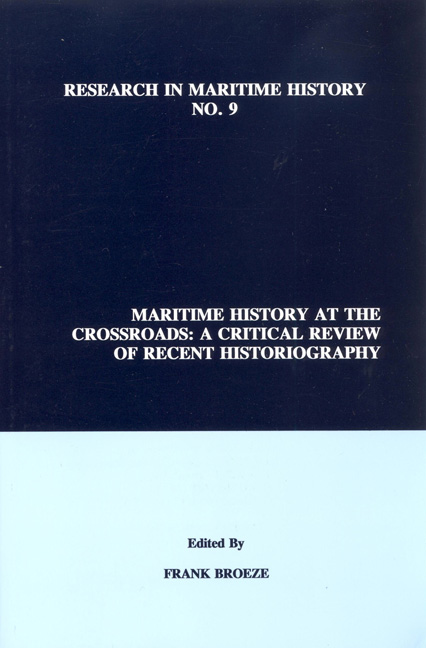Book contents
- Frontmatter
- Contents
- About the Editor
- Introduction
- Contributors
- “Maritime History in Australia”
- “The Enterprising Canadians: An Assessment of Canadian Maritime History since 1975”
- “The Historiography of Maritime China since c. 1975”
- “Danish Maritime History, 1976-1992: A Review”
- “German Maritime Historical Research since 1970: A Critical Survey”
- “The Maritime Historiography of Greece in Recent Decades”
- “Ibero-American Maritime History: Recent Advances in Research, 1975-1994”
- “Indian Maritime Historiography: West Coast Merchants in a Globalizing Economy”
- “Recent Developments in the Historiography of Maritime History in the Netherlands”
- “The Ottoman Empire: Recent Research on Shipping and Shipbuilding in the Sixteenth to Nineteenth Centuries”
- “The Progress of Maritime History in Spain since 1975”
- “Oceanic Historiography: The American Dimension”
“The Historians and Maritime Labour, c. 1850-1930”
from Contributors
- Frontmatter
- Contents
- About the Editor
- Introduction
- Contributors
- “Maritime History in Australia”
- “The Enterprising Canadians: An Assessment of Canadian Maritime History since 1975”
- “The Historiography of Maritime China since c. 1975”
- “Danish Maritime History, 1976-1992: A Review”
- “German Maritime Historical Research since 1970: A Critical Survey”
- “The Maritime Historiography of Greece in Recent Decades”
- “Ibero-American Maritime History: Recent Advances in Research, 1975-1994”
- “Indian Maritime Historiography: West Coast Merchants in a Globalizing Economy”
- “Recent Developments in the Historiography of Maritime History in the Netherlands”
- “The Ottoman Empire: Recent Research on Shipping and Shipbuilding in the Sixteenth to Nineteenth Centuries”
- “The Progress of Maritime History in Spain since 1975”
- “Oceanic Historiography: The American Dimension”
Summary
In recent years maritime and labour history have shown a commendable tendency to bridge the chasms that all too often exist between various specialisations. Although this chapter reflects on recent advances in labour history, it also offers a considerable degree of maritime coverage. No maritime endeavour could exist without the labour of dockers (in other English-speaking countries known as waterside workers, wharfies or longshoremen) and seamen. Although other occupations, including those associated with the shipbuilding and repair industries, are also part of maritime labour, this chapter will largely deal with these two groups. Its geographic and political focus will, with an occasional glance elsewhere, be directed on Great Britain, Australia and New Zealand. The maritime labour markets of these three countries were closely linked through the mobility of the seamen and the international perspectives of their unions, as well as because many of the shipping companies operating in their waters were closely connected. Indeed, throughout the period, British shipping was by far the greatest employer of maritime labour in the world.
Early Organisation
The trade increases of the early 1850s gave British port workers an opportunity to organise and strike, a point noted by John Lovell in 1969. The significance of this was debated then and later, since it relates to the way in which nineteenth-century labour is to be understood. Eric Hobsbawm had argued that periodic labour “explosions” were at first functions of destitution, wage policies, and problems of food distribution, but were replaced gradually by patterns connected in complex ways to the trade cycle. This interpretation was criticised, as was the characterisation of the third quarter of the century as dominated by a “labour aristocracy” in the form of new craft unions with restricted entry, an emphasis on benefits and a disinclination to strike.
Other studies have provided more detail on early maritime labour organisation while affirming its essential character. At the two most significant British ports, London and Liverpool, dock workers’ strikes were brief and unions ephemeral. Seafarers were not much different. There was a strike involving 8-10,000 people in 1851 in these and other ports that secured a wage increase, but seafarers were more conscious of the disciplinary features of the 1850 Marine Act than of the alleged protection it afforded from coercive treatment by masters and shipowners.
- Type
- Chapter
- Information
- Maritime History at the CrossroadsA Critical Review of Recent Historiography, pp. 277 - 294Publisher: Liverpool University PressPrint publication year: 1995



